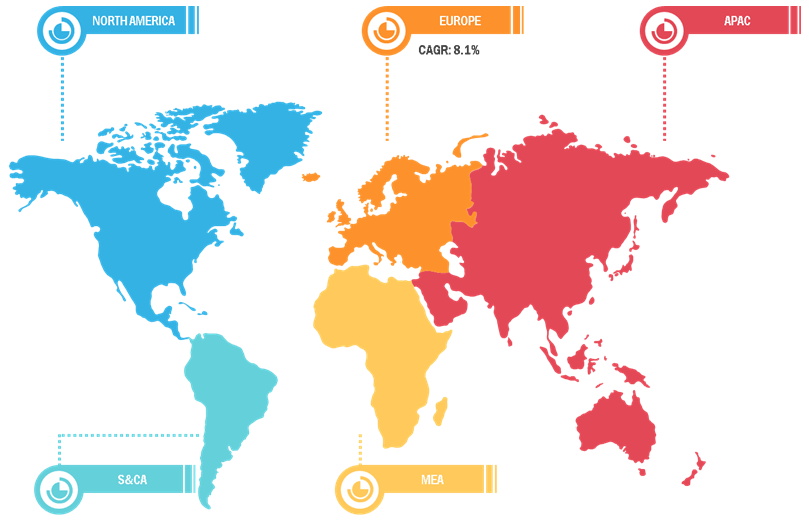According to our latest market study on “Natural Gas VehicleMarket Forecast to 2027 – COVID-19 Impactand Global Analysis– by Fuel Type (CNG and LNG),Application (On Road and Off Road), and Vehicle Type (Passenger Vehicles, Light and Commercial Vehicles, and Heavy Commercial Vehicles),” the market was valued at US$ 17,100million in 2019 and is projected to reach US$ 28,805.75million by 2027; it is expected to grow at a CAGR of 6.9% from 2020 to 2027.
Europe led the global natural gas vehicle market with 8.1% revenue sharein 2019, followed by Asia-Pacific (APAC)and North America. EuropecomprisesGermany, Italy, Russia, the UK, France,and the Rest of Europe. Automotive is one of the major manufacturing industries in European countriesas it considerably contributes to the countries’ gross domestic product. Also, several premium automotive manufacturers are based in the region. The vehicles andfuelling stationsare constantly growing across Europe. LNG and CNG primarily consist of methane that is progressively generated from renewable sources in biomethane and synthetic natural gas. The rising production of commercial and passenger vehicles generates huge demand for natural gas vehicles. Moreover, growing investments in sustainable transport and increasing need for alternative fuel technology would accelerate the natural gas vehicle market growth across various European countries in the coming years.
In 2019, Asia-Pacific stoodsecond in the natural gas vehicle market with a decent market share; it is anticipated to register a steady CAGR from 2020 to 2027.In the past five years, capital investment in technological development has grown by 6.3%in Europe, to reach US$ 7,313.09 million of capital investment in 2019.International Energy Agency stated that apart from South America, APAC is the leading region in the natural gas vehicle industry.The increasing disposable income of individuals and rising economy have bolstered the sales of passenger cars and commercial vehicles in the past few years. APAC has become a global manufacturing hub with the presence of a robust automotive and transportation industry. Government initiatives—such as Made in China 2025 and Make in India—propel the growth of this sector in APAC countries. Developing infrastructure, increasing domestic consumption, as well as low labor costs are the key factors attracting automotive and transportation companies in southeast Asian countries. Based on the pollutant emissions, natural gas vehicles perform exceptionally wellthan diesel vehicles—especially in heavy commercial vehicles. Optimizing air quality is expected to be a significant driver for natural gas in various APAC countries, such as India, Malaysia, Singapore, and Thailand. Expansion of gas markets, public transportation, and the economy in the region drives the growth of the market.
Companies adopt inorganic market strategies to expand their footprints across the world and meet the growing demand. The market players present in the natural gas vehicle market are mainly focusing on gaining approval by integrating advanced features and technologies. By signing partnerships, contracts, joint ventures, and inaugurating new offices across the world, companies are increasing their market share and brand presence. Most of the market initiatives were observed in North America, and Europe, which have a high potential for future market growth. For instance, in 2019,Agility Fuel Solutions for medium- and heavy-duty commercial vehiclesreceived 2019 California Air Resources Board (CARB) certifications for its natural gas fuel system for installation on General Motors 6.0L gasoline engines.
Impact of COVID-19 Pandemicon Natural Gas VehicleMarket
The COVID-19 outbreak isadverselyaffecting the world and is continuing to shatter several countries. Until the outbreak, the automotive and transportation industry was experiencing substantial growth in terms of production and services; however, the outbreak is tremendously disrupting the supply chain and production of automotive and transportation. The automotive manufacturing and transportation industry is heavily dependent on manual labor. Owing to the strong lockdown regulations imposed by the majority of the countries across the globe, the industry is experiencing a significantly lower number of labors in respective manufacturing facilities. This factor is hinderingthe automotive and transportation industry, thereby restrainingthe growth of the natural gas vehicle market.
Natural Gas VehicleMarket — Geographic Breakdown, 2019

Natural Gas Vehicle Market Analysis by 2027
Download Free Sample
Natural Gas Vehicle Market Forecast to 2027 - COVID-19 Impact and Global Analysis By Fuel Type (CNG and LNG), Application (On Road and Off Road), and Vehicle Type (Passenger Vehicles, Light and Commercial Vehicles, and Heavy Commercial Vehicles)
Natural Gas Vehicle Market Analysis by 2027
Download Free SampleNatural Gas Vehicle Market Forecast to 2027 - COVID-19 Impact and Global Analysis By Fuel Type (CNG and LNG), Application (On Road and Off Road), and Vehicle Type (Passenger Vehicles, Light and Commercial Vehicles, and Heavy Commercial Vehicles)
The report segments the global natural gas vehicle market as follows:
By Fuel Type
- CNG
- LNG
By Application
- On-Road
- Off-Road
By Vehicle Type
- Passenger Vehicles
- Light and Commercial Vehicles
- Heavy Commercial Vehicles
By Geography
- North America
- US
- Canada
- Mexico
- Europe
- France
- Germany
- Italy
- UK
- Russia
- Rest of Europe
- Asia Pacific (APAC)
- China
- India
- South Korea
- Japan
- Australia
- Rest of APAC
- Middle East and Africa (MEA)
- Saudi Arabia
- UAE
- South Africa
- Rest of MEA
- South America (SAM)
- Brazil
- Argentina
- Rest of SAM
Contact Us
Phone: +1-646-491-9876
Email Id: sales@theinsightpartners.com